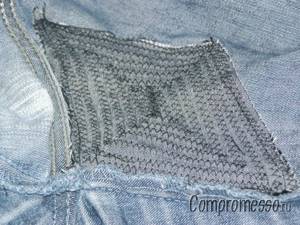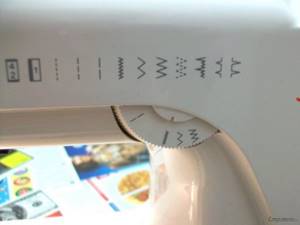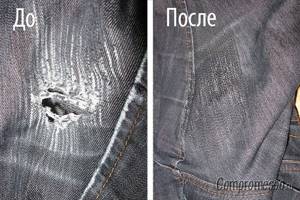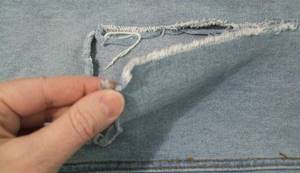Is it worth sewing up jeans?
In fact, will such a renovation be of any use? It definitely will. High-quality denim fabric lasts a very long time, but the high cotton content in the composition and increased load cause it to wear out over time. Most often, a hole in jeans appears on the knee, on the butt, between the legs, and also along the bottom of the trouser leg. With proper repairs, the life of your favorite jeans can be doubled!
There are several ways to remove a hole in jeans:
1. apply a neat patch;
2. if the hole looks like a cut, just stitch it up;
3. apply darning.
What if there is a hole in the knee?
Scuffs or holes on jeans in the knee area occur quite often. And repairing these areas requires special skills in operating a sewing machine. Especially when it comes to men's jeans, because women's models can be safely decorated with appliqués or other types of finishing.
So, to hide a hole in the knee, you need to do darning - a special type of darning in which stitches are made in both directions - back and forth. If we are talking about how to quietly sew up a hole in jeans, then sewing it with matching threads is the ideal option.
Materials:
a piece of fabric for a patch;
a small piece of non-woven fabric (slightly larger than a patch);
threads for denim fabrics.
Instructions:
- Cut out a patch from the fabric and apply it to the hole or abrasion on the wrong side.
- We put a piece of non-woven fabric on top and iron it with an iron.
- We set the average stitch length and begin to make a stitch that fills the hole - first we direct the stitch forward.
- Switch to reverse, shift the fabric by the width of one thread and make a stitch.
- After finishing the work, carefully cut off the excess interlining and patch fabric.
The best way to sew up a hole is to make an original design for the item. For this you can use:
- appliques (if there are holes on the knees or, for example, on the butt);
- additional pockets;
- patches with a finishing seam (after sewing the patch on the outside, a double or triple finishing stitch is applied);
- overlays with fringe (a patch is applied on the inside, it is sewn along the edges of the damaged area of the jeans, and on the outside the hole is disassembled using separate transverse or longitudinal threads);
- piece with contrasting threads.
How to sew up jeans discreetly
If wearing ripped jeans isn't your plan, they need to be repaired immediately! This service is provided by most studios, but if you have a sewing machine, you can do this work on your own. You just need to find pieces of denim in the right color. By the way, never throw away the scraps left after shortening your trousers: they can still serve a good purpose.

First, trim the threads sticking out along the edge of the hole. Turn the jeans inside out and mark a contour around the hole 1-2 cm larger than its size. Make sure that the patch will be placed on a strong, non-fraying fabric. If it is clear that the material around the hole will also soon deteriorate, increase the size of the patch. Treat the edges of the patch so that they do not fray. Place it on the wrong side of the jeans and secure with pins or a few large stitches. Turn the jeans right side out and carefully stitch the edges of the hole along with the patch fabric. It is best to do this with a zigzag seam. If you want the patch to be as invisible as possible, choose threads to match your jeans.

A hole in jeans between the legs is a little more difficult to repair. You will have to separate the fabric sheets at the seam, put a patch on each sheet, and then sew them again.
How to sew up a hole in your knee with your hands?
It will not be possible to sew jeans at the knee without it being noticeable. However, for lovers of handmade work, in this case there are many opportunities to show creative imagination.
We invite you to read why the Indesit Know Frost refrigerator does not turn off
Below are some of the most obvious options for decorating a hole in the knee:
- Denim patch in contrasting color.
- A patch made of printed fabric of a different type and texture.
- Contrasting decorative darning.
- Application.
- Leather patch.
Decorative patches can be sewn on the front side or peeking out from the gap on the back. They can be done on both knees, placed symmetrically, or on just one.
How to sew up a crack in denim
If the worn-out fabric has cracked and a gap has formed, it is easy to remove. It is enough to trim the “shaggy” edges to a minimum, align them and sew with a zigzag seam. However, if the fabric has already become too thin, this method will not help for long. To make the seam strong, you will first have to apply a strip of thick fabric to the back of the jeans, and only then sew the edges together with additional fabric.
You can also repair a horizontal or vertical hole in jeans with adhesive cloth: in this case, first place the adhesive material under the torn area, accurately align the torn edges, iron everything with a hot iron, and then proceed to create a beautiful and even stitch.
Darning jeans
It also happens that the material has worn through, but there is no hole yet. In this case, it is convenient to use the darning technique on a sewing machine. You just need to choose the threads that best match the color of your jeans. To mend a hole in jeans, set your sewing machine to the straight stitch setting and make several parallel stitches on the fabric, placing them close together. Depending on the result obtained, it is recommended to make several perpendicular lines. This will help compact the fabric and after steaming the darning area will be almost invisible. This technique can also be used if a hole has already appeared in the jeans, to strengthen the fabric in adjacent areas.

So, it’s possible to save your favorite and often expensive jeans! To sew up a hole in your jeans, you only need basic sewing skills and a great desire to preserve your favorite item.
How to mend a hole in jeans?

Are your favorite jeans torn? Don't be upset. The situation can be improved. Firstly, if the hole turns out to be picturesque and in a suitable place, you can leave it. Ripped jeans are very fashionable and stylish. Secondly, the hole can be carefully sewn up if it is not too large, vertical, horizontal or in the shape of a corner. Thirdly, you can apply a patch: from the same fabric or from fabric of a contrasting color. Fourthly, you can glue a decorative appliqué in place of the hole. Well, fifthly, a large hole or tear can be mended.
Method 1:
Ripped Jeans
If you are ready to wear stylish ripped jeans, then the rip should not bother you.
On the contrary, this is an occasion to show your creativity. The hole needs to be “ennobled”: enlarged, if necessary, horizontally, ruffle the edges. But one hole is not enough; you need to make at least a couple more. Typically, holes in jeans are located asymmetrically, on the hips, knees and below the knees. Method 2: Sew up a hole in jeans
A hole in the shape of a straight cut or a cut at an angle can simply be sewn up.
Here it is important to choose threads of a suitable color; they should not differ from the color of the jeans by a single tone, then the place of repair will not be obvious. Sew up the horizontal tear by hand using simple, small, tight stitches. Accuracy is very important here: each new stitch must be exactly the same size as the previous one. The stitches should go very closely to each other, there should be no distance between them. Method 3: Patch
The patch can be made of the same fabric as the jeans. If you have shortened your jeans and have some scraps left over, this is the best option since the fabric will be no different. So, we put a patch on the jeans:
- Determine the size and shape of the patch. To do this, outline the outline of the hole with allowances of one or two centimeters, depending on the size of the hole. The patch, like the hole, is usually given the correct shape.
- The edges of the patch are processed with a zigzag on a machine or overcast by hand.
- The patch is placed under the hole so that the edges of the patch are on all sides at the same distance from the edges of the hole. The patch is secured with safety pins and basted by hand.
- Attach the patch to the jeans fabric using a straight machine stitch or zigzag stitch.
If you don't have denim that matches your pants, there are other options. For example, make a patch from denim in a contrasting color: white, black, dark blue or light blue. A leather patch is suitable for men's jeans. Women may like a patch made of organza, lace, chiffon, or thick fabric with a small pattern. It can be checkered fabric, floral fabric, patterned fabric. For symmetry, you can make another decorative patch filled with the same fabric. The edges of the patch may not be trimmed neatly, but, on the contrary, may become tattered. Or cover it with decorative braid, rhinestones or beads. Another idea is to give the hole some interesting shape: a star, a diamond, a heart. Method 4: Applique

In the store you will find applications for every taste. It may hardly differ in color from your jeans, or it may be contrasting. There are appliques made of denim, with an embroidered inscription or design. There is a very large selection of children's applications on sale: with cartoon characters, flowers, cars and other images that are interesting to children. There are other applications that are more appropriate for adults. Glue the applique using an iron, melting its adhesive base and securing it to the jeans fabric. Unfortunately, after several washes the applique may come off. Therefore, for reliability, you can stitch it with a machine seam along the edge or sew it by hand with a few small stitches in the corners. Making an applique yourself is not at all difficult. You can cut out a geometric shape, a flower, a mushroom, a cat's head, a house or something else from leather or other fabric. You can decorate the applique using beads, braid, buttons and beads. You can embroider something on it, for example, a cat's whiskers, if the applique is cut out in the shape of a cat's head. The applique is glued using double-sided interlining or simply sewn on. Of course, applique is primarily suitable for children's clothing. Your child can even take part in the development of her project and its implementation. Method 5: Darning
You can mend a hole in your jeans using a sewing machine, although some people do it by hand. Stages of work:
- We select threads of a suitable color. If you can’t find a completely matching tone, you can take threads of two shades, a little lighter and a little darker than what you need. And use them for the bottom stitch (insert into the bobbin) and for the top (insert into the needle).
- Make several zigzag stitches to join the edges of the hole. The seams can be either horizontal or vertical, depending on the location of the hole. These seams will not only join the edges, but will also create a foundation for further darning.
- Next you need to apply parallel seams very close to each other. This is done like this: you lay one line, which begins and ends one or two centimeters from the edges of the hole, turn the fabric one hundred and eighty degrees and lay another line next to the first. Repeat this step until you have stitched the entire hole. Seams are most often placed vertically, so that they match the structure of the denim fabric.
- It is better to make the edge of the darning blurred so that the repair site is invisible. To do this, some seams are made longer, and on the sides of the darning the seams should be gradually shortened.
- Do not pull the fabric too tightly while stitching, otherwise it may end up with unsightly waves.
- If the hole is large, then before starting darning, you can sew a patch of a suitable color on the wrong side. In this case, the stitches pass directly along the patch, sewing it to the jeans. In this case, it is not so important that the fabric of the patch matches the color of the jeans, but it should still be similar.
Thus, a hole in the jean is not a reason for grief and disappointment, but an opening for creativity and giving a new look to good old clothes.











